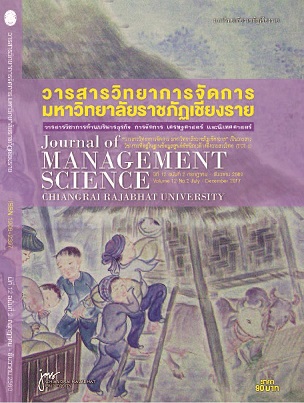Factor impacting media-literacy on sex among undergraduate students in Chiang Rai and Chiang Mai
Main Article Content
Abstract
The research “Factor impacting media-literacy on sex among undergraduate students in Chiang Rai and Chiang Mai” purposes 1) To study the students' opinion upon sexual values among the undergraduate students, 2) To study the level of media literacy , and 3) To study the factors influencing the students’ media literacy in the aspect of sex. This research is the Quantitative research; the questionnaire to collect information from 400 university students in Chiang Mai and Chiang Rai provinces with the use of multi-stage random sampling, percentage, S.D., and multiple regression.
There are numerous findings from this series as follows. 1) The sample group shows high level of opinion upon sexual values (x=3.49). When considering from each category, it reveals that the students agree with the good sexual values in the aspect of Thai society, which believe that men are supposed to show their responsibilities upon women i.e., not cheating and not taking advantages which shows the highest average (x=4.28). The young people nowadays seem to use emotions when making decision rather than reasons (x=4.09). At presents a number of couples devoice due to their different tastes (x=3.73). These are considered the inproper values among Thai society. 2) The sample groups shows high level of media literacy in the aspect of sexual values (x̄= 3.55) being the 3rd level, which means they can evaluate the media. 3) The factors influencing the media literacy in the context of sex among the students are family (parents) which shows the highest average (x̄= 4.34), as well as their self-realization thinking that the educational institutes need to teach students to realize their roles for themselves and for others (x̄= 4.12). Moreover, family, education and media also influence the students' media literacy.
Article Details
Views and opinions expressed in the journal do not necessarily reflect those of the editors.
References
นงลักษณ์ เอมประดิษฐ์ และคณะ. (2540). ความรู้ทั่วไปเกี่ยวกับเพศศึกษา. พิมพ์ครั้งที่ 2. กรุงเทพฯ : มหาวิทยาลัยธรรมศาสตร์.
นภาพร ธนะนุทรัพย์. (2551). อิทธิพลของสื่อละครทางโทรทัศน์ต่อพฤติกรรมด้านจริยธรรม:กรณีศึกษา นักศึกษาระดับปริญญาตรี มหาวิทยาลัยมหิดล.
ปิยวร กุมภิรัตน์. (2546). ปัจจัยทางสังคมและวัฒนธรรมที่นำไปสู่พฤติกรรมเสี่ยงทางเพศของวัยรุ่นในจังหวัดแพร่. วิทยานิพนธ์ ศึกษาศาสตรมหาบัณฑิต (สาขาวิชาการส่งเสริมสุขภาพ) มหาวิทยาลัยเชียงใหม่.
ยุพดี ฐิติกุลเจริญ. (2537). ทฤษฎีการสื่อสาร. กรุงเทพฯ : โรงพิมพ์ชวนพิมพ์.
วิลาสินี พิพิธกุล. การสื่อสารเรื่องเพศในสังคมไทย. กรุงเทพฯ : สำนักงานกองทุนสนับสนุนการวิจัย.
พรทิพย์ เย็นจะบก. (2548). คู่มือการเรียนรู้เท่าทันสื่อ. สำนักพิมพ์ปิ่นโต พับลิชชิ่ง. กรุงเทพฯ.
พรทิพย์ เย็นจะบก. “การรู้เท่าทันสื่อบนสถานการณ์ความขัดแย้งทางการเมืองของประเทศไทย : กรณีศึกษาเฉพาะสื่อกระแสหลักและสื่อใหม่ ในช่วงเวลาหาเสียงเลือกตั้งปี พ.ศ. 2554” บทความ. คณะมนุษย์ศาสตร์ ภาควิชานิเทศศาสตร์และสารสนเทศศาสตร์ มหาวิทยาลัยเกษตรศาสตร์. 2556.
สุขุมาล จันทวี. (2550). การวิเคราะห์เพลงไทยสากลแนวใหม่ในช่วงปี พ.ศ.2524-พ.ศ.2534. วิทยานิพนธ์ นิเทศศาสตรมหาบัณฑิต. จุฬาลงกรณ์มหาวิทยาลัย.
สุพัตรา บุญญานุภาพพงศ์. (2548). ปัจจัยที่มีผลต่อค่านิยมทางเพศของวัยรุ่นในเขตกรุงเทพมหานคร. วิทยานิพนธ์ปริญญามหาบัณฑิต จุฬาลงกรณ์มหาวิทยาลัย.
อุณาโลม จันทร์รุ่งมณีกุล. (2549). เปิดประตูสู่การรู้เท่าทันสื่อ : แนวคิดทฤษฎีและประสบการณ์การรู้เท่าทันสื่อเพื่อสุขภาพ. นนทบุรี : โครงการสื่อสร้างสรรค์สุขภาพ.
Bate, J., &. Theory of media literacy : A cognitive approach. California : Sage Publication. 2007.
McCombs, Maxwell E. and Becker, Lee B. 1979. Using Mass Communication Theory. N.J : Prentice Hall, Inc. (1979).
Potter, W., J. Media Literracy. UK : Sage publications, 1998.
Silverblatt. Media Literacy: Keys to Interpreting Media Messages. 1995.


